It can be argued that Leroy Street is the most unusual street in all of Manhattan, and perhaps all of New York City.
What other street can claim:
- That it is called by two separate names — and the entire street isn’t known by two names, but only a portion of the street is called a different name.
- The street’s two names occur within the same block, with a bend in the street determining what name is used.
- There are two different house numbering systems, and while one runs east to west, the other runs west to east.
I’ll get into those in some detail later on, but first, here’s a rundown of the street from Hudson east to Bleecker. Overall, Leroy Street’s numbering begins at Bleecker and runs west to the Hudson River, but there’s an exception.
Leroy, spelled Le Roy on older maps, is two blocks north of King Street, and both mean the same thing — though King Street was named for Rufus King, a statesman and abolitionist in the Revolutionary era whose mansion in Jamaica is now a museum, while Le Roy honors Alderman (today’s City Councilman) Jacob Le Roy, an early area shipping merchant who ran a blockade against the British in the War of 1812.
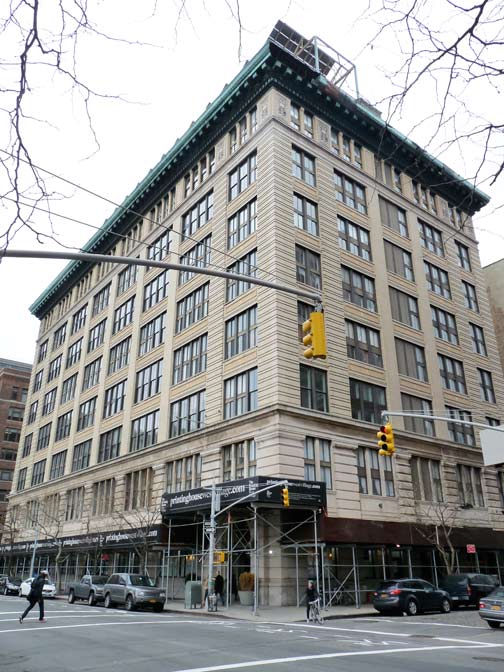
421 Hudson Street at Bleecker is an Italian palazzo-style warehouse built in the late 19th Century or 1911, depending on your source (it didn’t make the AIA Guide to New York City) and it probably was home to printing plants at some time in the past: I worked briefly at a publishing house on Greenwich Street in the mid-1990s, paginating books using QuarkXPress. It was converted to apartments in 1979 (Tiger Woods purportedly is a former tenant) and is condo-izing under its new name, Printing House West Village, to open in 2013.
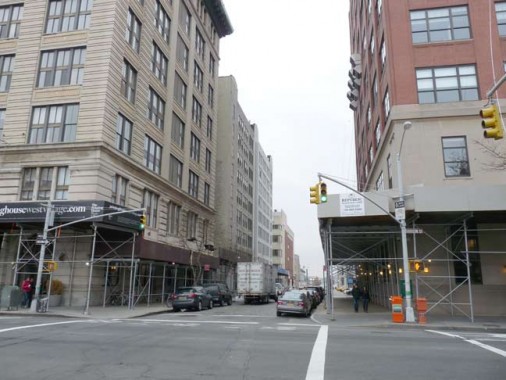
Between Hudson and West Streets, Leroy isn’t something to write home to Mother about, unless you’re a Belgian block pavement fan. I wonder if someone in town has ever surveyed and notated Manhattan’s (and the other 4 boroughs’) remaining Belgian brick pavements. Perhaps I should consult friends who have walked every block in Manhattan. Yes, I know more than one.
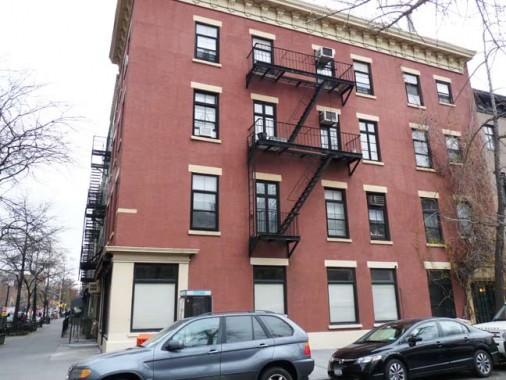
Diagonally across the street from 421 Hudson is 420, which is also #1 St. Lukes Place (not Leroy Street — I will explain presently).
This handsome 4-story red brick building has 3 floors of apartments and business on street level; it is the former home of sculptor Theodore Roszak, whose industrial style, epitomized in his Sentinel near Bellevue Hospital, isn’t my cup of tea, but has many adherents.
In a Forgotten NY vein, what’s interesting about the building is its chiseled corner street signs, which unique among the ones I’ve found, helpfully list the building’s numbers along with the street names.

 1834 map of what became Leroy Street. Sorry it’s a little fuzzy, but the original was small and I blew it up somewhat. The east end of the street beginning at Bleecker was originally called Burton, and dead ended at an uptown branch of Trinity Cemetery, established in 1801 as a churchyard for the long-razed St. John’s Chapel; it was bordered by Hudson, Carmine, and Morton Streets. Meanwhile, Leroy Street went only from Hudson to West Street.
1834 map of what became Leroy Street. Sorry it’s a little fuzzy, but the original was small and I blew it up somewhat. The east end of the street beginning at Bleecker was originally called Burton, and dead ended at an uptown branch of Trinity Cemetery, established in 1801 as a churchyard for the long-razed St. John’s Chapel; it was bordered by Hudson, Carmine, and Morton Streets. Meanwhile, Leroy Street went only from Hudson to West Street.
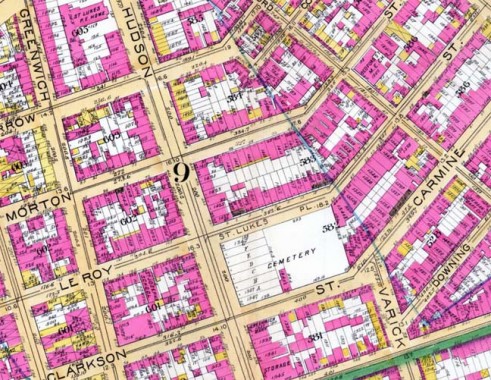
In 1845, Burton was connected to Leroy by extending it through the cemetery, and the connector street was named St. Luke’s Place after the nearby St. Luke-in-the-Fields Church. Imagine in the above map a street running through the cemetery continuing on an angle from the stump of Burton Street. The Burton name fell out of favor, and was thenceforth part of Leroy. However, the St, Luke’s Place name stuck along the section of Leroy Street that faced the old cemetery (as shown in this 1892 map).
Though the cemetery inspired Edgar Allan Poe to write several macabre tales when he lived in the area in the 1830s, it was closed by 1898 and turned into Hudson Park, a high-concept collection of lush marble terraces and gazebos built by renowned architects Carrere and Hastings. Many of those interred in the cemetery were moved to other burial grounds between the 1850s and 1900, such as uptown Trinity Cemetery at Broadway and West 155th. Some, however — as many as ten thousand — simply remained in place, their tombstones and markers uprooted or plowed under by the City. The Carrere/Hastings vision lasted only 8 years and was then replaced by a more mundane city park.
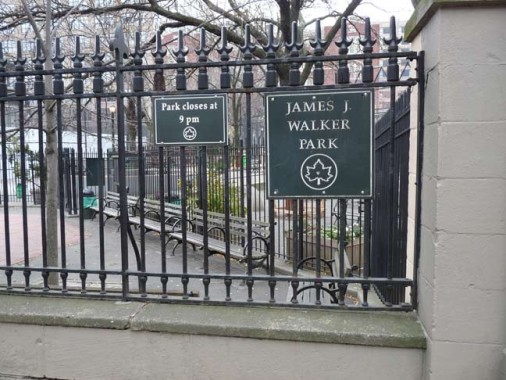
Today no trace remains of the lush landscaping, as Hudson Park in 1947 was renamed James J. Walker Park after the 1920s NYC mayor “Beau James” or “Jimmy.” Today the park consists mostly of ballfields and also a swimming pool (seen in the film Raging Bull).
In 1914 Walker was elected to the State Senate with the endorsement of Tammany Hall. As Senator, he lobbied successfully for the legalization of Sunday baseball and professional boxing, while continuing to work as a lawyer. Jimmy Walker—also known as “Beau James”—socialized with stars of the Broadway stage and the sports world and became known for his stylish dress. In 1925 he ran a victorious campaign for mayor, again with the endorsement of Tammany Hall. During his first term, he founded the Department of Hospitals, preserved the nickel subway fare, and rooted out corruption in the Police Department and Department of Health.
Shortly after Walker won a second term in 1929, an investigation led by Samuel Seabury was launched to determine if he had accepted bribes for municipal contracts; his relationship with the actress Betty Compton also caused a sensation. Resigning in 1932, after formal charges of corruption had been filed, Walker left for Europe, divorcing his wife and marrying Compton. Returning to New York in 1935, the couple adopted two children; they divorced six years later. In 1940 Mayor Fiorello D. LaGuardia appointed Walker labor arbitrator for the garment industry, and Jimmy became a popular speaker at banquets and rallies. James J. Walker died on November 18, 1946… NYC Parks
The only remnant of the cemetery visible to the eye is this firemen’s memorial, set in place in 1834, honoring Engine Co. 13 firemen Eugene Underhill and Frederick J. Ward, who were 20 and 22 years old, respectively. They perished fighting a blaze in Pearl Street, crushed to death under a falling wall. When the plot became a park the memorial was moved to the St. Luke’s Place side.
As reported by The New York Times, “In this amusement resort, which presents a scene of revelry and gayety every afternoon, stands the only survivor of the days when the park was used as the cemetery for the doomed St. John’s Chapel…The changed conditions of the place are well expressed by this inscription on a brass tablet placed there in 1898: The City of New York devotes to the service and comfort of the living this ground formerly used by Trinity Parish as a burial place for the dead, whose names, although not inscribed, are hereby reverently commemorated.” Daytonian in Manhattan, which has photos of both the cemetery and the park that replaced it.
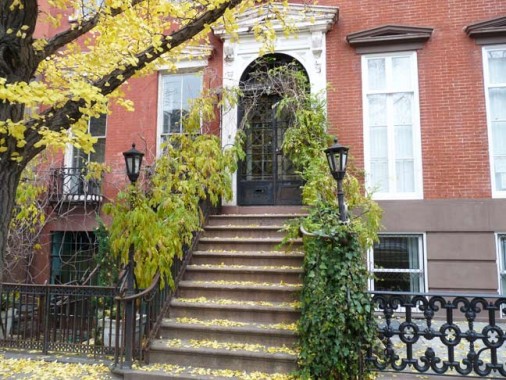
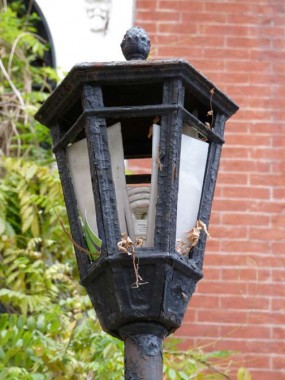
James J. Walker Park is so named because Mayor Walker lived here, at #6 St. Luke’s Place, during the years he was in office. His father had purchased it in 1891, in a row of handsome row houses that were constructed in the 1850s, shortly after St. Luke’s was extended through the cemetery. Three buildings on St. Luke’s have twin lamps decorating the entrance gate, but these are in place to honor the former home of a mayor –it’s considered something of a tradition. Mayor James Harper’s house on Gramercy Park West also has the lamps.
From the looks of things the building appears to be between owners, as it is somewhat shabby and dilapidated.
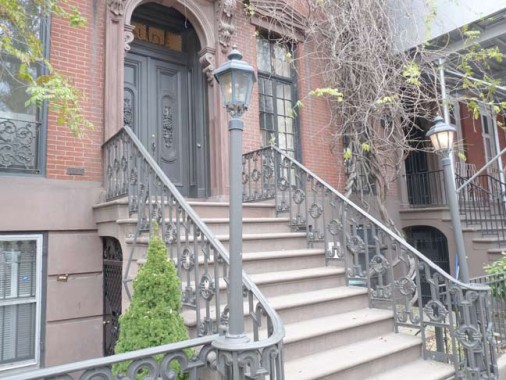
Another pair of lamps, at the better-kept #9 St. Luke’s Place. As previously mentioned, St. Luke’s Place buildings are numbered 1 to 17 and both even and odd numbers are in a row running west to east on the north side of the street. At the midblock bend in the road, Leroy Street resumes, and the house numbers begin running east to west, with the odd numbers on the north side and the even numbers on the south side.
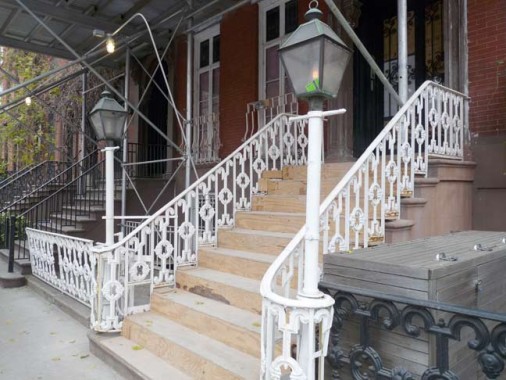
Another pair of lamps, at the scaffolded #10 St. Luke’s. This house served as exterior shots for the Huxtable family’s house in the long-running Cosby Show in the 1980s and 1990s.
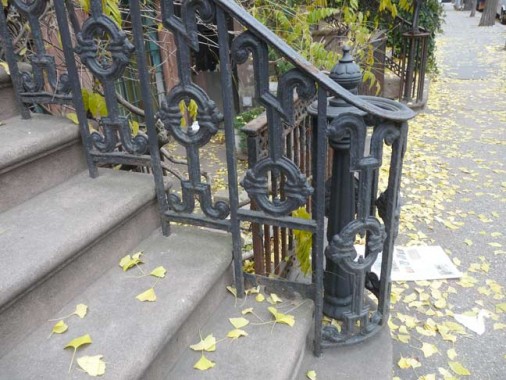
Many houses still have original railings, or at least very old ones. This one has a boot scraper to get the mud off shoes in the days before sidewalks or welcome mats. The leaves are from the pungent ginkgo, which lines the block.
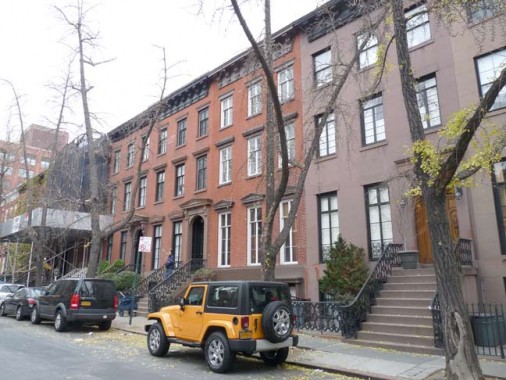
North side of St. Luke’s Place, with #10 at the far left. The block has been home to editor Max Eastman, author Sherwood Anderson and Theodore Dreiser, writer-director Arthur Laurents (Gypsy) and poet Marianne Moore. #4 St. Luke’s Place was the home of the blind and terrorized Audrey Hepburn character in Wait Until Dark.
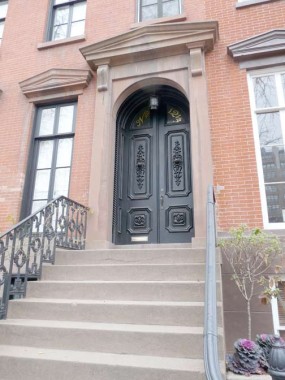
#12 1/2 was the home of civil rights attorney Leonard Boudin, and his daughter, Weather Underground terrorist and later public health expert Kathy Boudin.
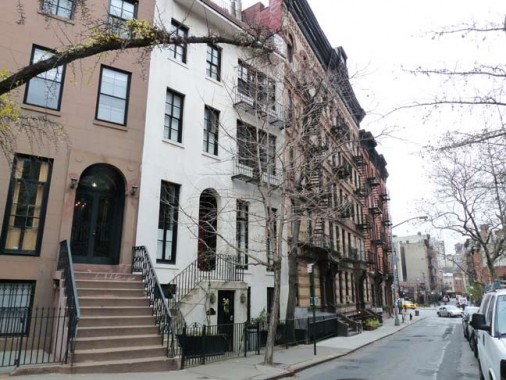
#17 St. Luke’s is the highest numbered St.Luke’s address. East of here it’s Leroy Street again.
Ceramic ornamentation in the Walker Park playground by artist Lillian K. Rosenberg, installed in 1974.
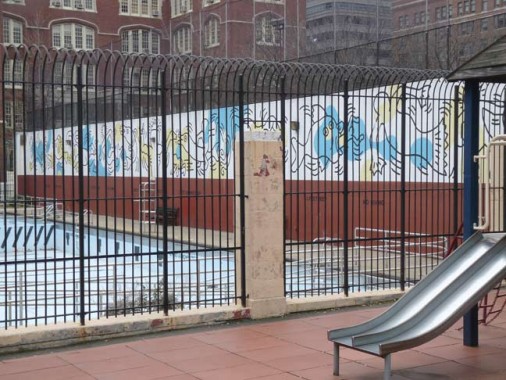

Keith Haring mural, Carmine Street Pool at the Tony Dapolito Recreation Center, facing Leroy Street. The late great muralist (1958-1990) painted this 18 by 170-foot wall with mermaids and sea-things in 1987. I was able to get onto the roof of the recreation center while giving a chat here just after the release of the ForgottenBook in 2006.
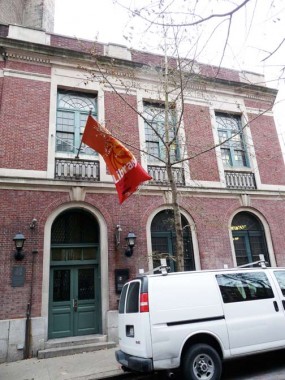
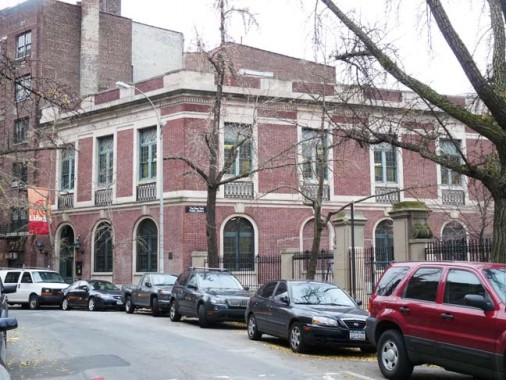
Hudson Park Branch, New York Public Library, 66 Leroy, honors the former name of Walker Park. It was built in 1906.

#51 Leroy Street at 7th Avenue South. Most of the jagged edges from the extension of 7th Avenue south from Mulry Square at Greenwich Avenue to Varick, Clarkson and Carmine Streets after 1912 have been smoothed over — it was run along the cut for the new IRT subway that year. Beginning in 1928, 6th Avenue was extended south in a similar manner.
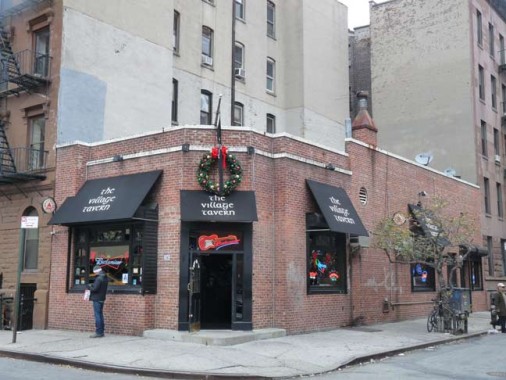
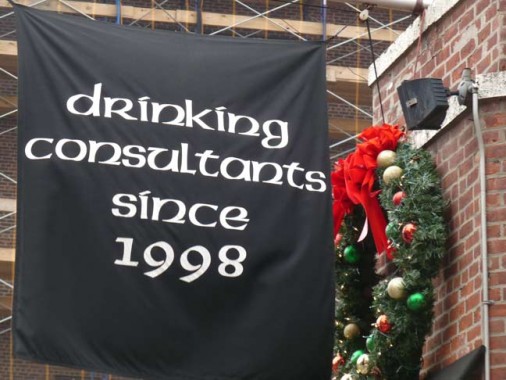
Village Tavern at Bedford and Leroy is coincidentally as old as Forgotten New York.
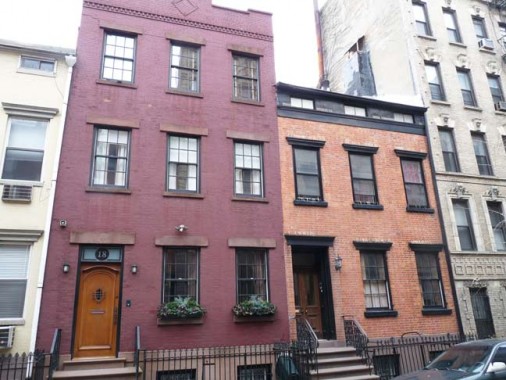
18 and 20 Leroy, between Bedford and Bleecker. These buildings go back to the 1840s.
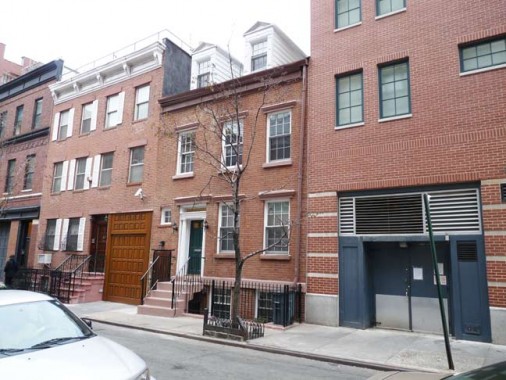
The dormered #11 Leroy, with adjoining #13, are about as old.

Leroy ends its northeast progress at Bleecker. Though they do not show much signs of age, these 4-story buildings go back to the 1830s.
12/2/12


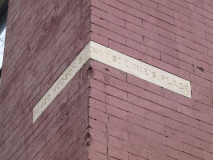
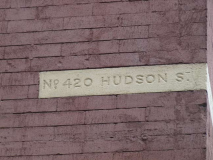
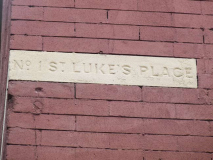
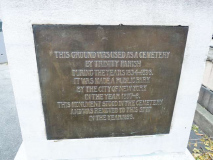
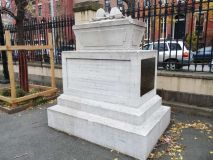
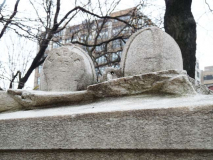
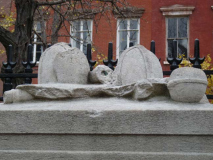
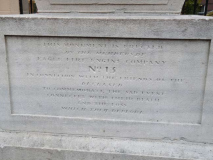
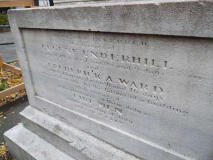
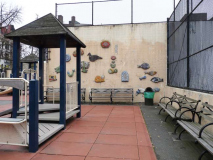
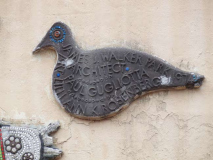
52 comments
The swimming pool in the park was also featured in the 1995 film Kids. The delinquents break into it on a hot summer night.
I spent a lot of my youth on Leroy – at Our Lady Of Pompeii school. The street was closed just for us to play on.
On the west corner of Leroy and Bleecker was an A & P, then in the late 70’s it became a ‘flea market’ of sorts. Now it’s Amy’s Bread, selling perhaps the most flavorless products known to man under the guise of artisanal bread. ( I miss Zito’s Bakery…. ) The rest of the building was torn down and made into a fancy condo.
I love this website, its always nice to see something so part of your life. cheers
I grauated from OLP in 1960. I also miss Zito’s and John Bosco’s. Their was a lunchnet next to Jhon’s pizzeria called Dirtywaters.
My great-grandmother’s family owned a blacksmith shop and stable on Leroy Street (or LeRoy Street) in about 1880 to about 1900 or so. Her maiden name was Fitzgerald, her cousins were named McGrath. I wonder if you happen to know where one or more stables might have been during that time?
Thanks,
sheila
I lived on Leroy street in the 50s-60s. My friend lived at number 13. He told me that at the turn of the century, there were stables behind his house. This was accessed through a large doorway on the right side of his house. In the 50’s, there was a thriving pushcart business that sold produce around the corner on Bleecker.. At the end of each day, these pushcarts were taken off Bleecker Street and stored at 13 Leroy Street until the next working day. Fond, fond memories.
Enzo, Was your friend’s name Bob Perrazzo? If so, you must be the Enzo Pocali who was a fellow Associate Prefect at Lincoln Hall in the early ’70’s. Are you still in the NYC area?
Hey Dennis. It’s Bobby Perazzo.
That’s was the pasionies. They owed the building
Enzo it’s Bobby Perazzo. If your out there please get in touch. bobperazzo@yahoo.com
Edward H. Larkin, my paternal great-grandmother’s brother lived on Leroy Street in 1880. He was married to a McGrath and he was a NYC Policeman. Do you have any information on him?
I don’t know too much about the McGraths except that they too were blacksmiths and metalworkers / artists. It’s my understanding that the McGraths were better educated than the rest of the family.
I grew up in this area & went to grammar school @27 Christopher St. I believe there were stables nehind Christopher on Gay St.
Dear Sheila, The New York Public Library and the New York Historical Society’s Library have city directories for that period. They usually have a yellow pages type section where companies are listed by function. I know because my Great great Uncle was a jeweler then and I found the location of both of his shops in that period.
Thanks.
I wish I could afford to live here…
I worked around the corner from the Walker home for quite a while. I have it on good authority that the street was split to confuse investigators who were out to confirm Walker’s affairs.
There was also a cast iron police shanty that stood by the eastern pole outside the house; it was demolished sometime in the early ’90s. It was customary then, as now, to station a police officer outside the mayoral home.
The same good authority has it that Walker was intoxicated on the night of his inaugural, and the assigned police officer would not allow him entry.
The pool at James J. Walker park is the pool they used for the poolside scene in the movie Raging Bull with Robert Deniro . He also owned a town house across the street on Leroy St.
Many tour guides who show off the area and the Leroy St. block and all of its rich movie history ,always seem to forget to mention that little rather famous fact .
My grandfather built and owned the white triangular building on the corner of Leroy and Seventh.What great times we had in the seventies and early eighties. Hello to Bobby and Mark if your out there!!
I lived at 22 Leroy st in the 50’s. I remember when the white corner building was being built. If I remember corectly, it took a very long time to build. Did your grandfather own the Duplex Club a couple of blocks north?
Yes he did. Jimmy Dimartino was his name. We would always sit out on that terrace. I was just recently downstairs at the cocktail lounge. It’s called The Now bar.
Tony above is my older brother, there were four of us, Tony, Vinny, Leo & Dan.
When we were kids, two brothers at a time would go and visit our Papa every Summer from late 60’s to early 80’s. We lived in Huntington Station out on the Island, and usually took the LIRR, via Jamaica, by ourselves. Great memories of making friends with the local kids, playing handball in the park and swimming in the pool, plus mischief during those hot Summer nights . . . Playing manhunt on the docks and harmless other stuff.
Also remember when the WTC was being built, we had a clear view from our terrace of the cranes on top. It was big time Italian back then . . . and Irish, so we fit in well.
Hi Anthony, I live on Christopher Street not far from The Duplex. I do a lot of research on Greenwich Village & have recently been trying to find out when The Duplex’s current building was built. I found out that the original 2 story triangular building, the 1st on that little plot, was built in 1922.by the owner of the building next door, that it was once a Cube Steak restaurant, that it was the 2nd office of The Village Voice.until ca.1973. But sometime between 1973 & 1989 when The Duplex moved to that spot, the building was drastically altered, as if it was torn down & replaced by the current building. Do you know anything about what happened during that time?
My husband live in apt 22-24 Leroy he moved out in 1957. His name was Joe and he had a brother Dom and two sisters
I grew up in 22-24 Leroy St. Until 1987. I was Seventeen when my parents mover
I’m looking for information on a Leroy’s bar and grill
My grandfather, Thomas Cassidy, grew up at 17 LeRoy Street during the late 1800’s.
He was a boyhood friend of Jimmy Walker’s who lived at #19. It appears that there is a garage at that location now. Does anyone have any history on the old building?
My cousin, Liza Condon, who died early in life in January 1999, lived on this street, and was instrumental in promoting the tree planting of the those ginkgoes on the block. Once a few were planted, it seemed the Leroy Street neighbors not only took notice, but also seemed to take new pride in their neighborhood, getting behind the effort and also doing other things to beautify the street, like planting flowers in window boxes.
Your cousin, Liza, was an angel back in the 1990’s just as she is today.
My grandmother Anna DiLonardo (Harman) owned and lived at 20 Leroy Street from about 1918 through 1978. For a few years prior to that, they lived at the tenement across the street, No. 15.
Her husband, Alfred DiLonardo, a tailor, passed away in 1927, and was laid out in the front room. Anna maintained her living space and rented out rooms, much as had been done there since the 1890’s. She continued in much the same manner until her death in 1978. Visiting as a child in the 1950’s, I remember being fascinated by dark green signage with raised lettering across the street (on the odd side) saying G B PERRAZO UNDERTAKER. There were large garage doors on that building,as well. I remember a Bobby Perrazo who lived on the even side, perhaps at No. 14.
We lived at 22-24 Leroy, I knew Bob Perazzo well. We worked together at the Lincoln Hall reformed school in Westchester county. I don’t think his family was related to the Perazzo undertakers on Bleecker St.
Sue what year did they plant those trees? I think it was 1969 if my memory serves me right.
I lived on Leroy Street, first at I think 19, then at 23 Leroy, around 1978/9 to 1987. My daughter was born there. Then we moved to King Street! I also have fond memories of Zito’s. Would go there every day for fresh bread. And on the corner of Morton and 7th Avenue South we stopped in every morning at Shopsin’s for coffee and croissants, sometimes a homemade soup.
i found a very old 1910 singer sewing machine on evening with a price tag of $600 on it outside #10 i believe, they were renovating the house. the sign had a phone number which i called. a construction worker said they tried to sell it but i could take it. the older lady had passed away and they were cleaning out the house. i wondered what else was in there and whose it was. i figured by how old it was they’d lived there for some time
I use to be the lifeguard from July 65 until September 68.I always thought it to be the most scenic area in Manhattan, and a few years back showed it to my wife and took pics on some of the stoops and while a student at PS 3 we would go to the park for P T and play ball.
Hey Bernard do you remember Hector the lifeguard? He pulled me out when I whacked my head on diving board trying to do gainer
I lived at 22-24 Leroy. I worked with Bob Perazzo at Lincoln Hall (reform) School in Westchester. The Perazzo Funeral Home was/is located on Bleecker Street just east of 6th Avenue. I don’t think the two Perazzo families are related.
Enzo. Get in touch Would love to get together
Lauren Zack says, ” I moved to the area in the early 80″s to Commerce St. and I remember that white building becoming an after-hours called “The Milk Bar”. It was rather mellow compared to the fun happening at Area, the Mudd Club, and of course CBGB’s. I preferred taking a walk on the wild side with the likes of Blondie, Johnny Thunders and of course the Ramones.
Just wanted to say that I have thoroughly enjoyed reading all the comments and history here.
Wasn’t there a club there back in 1986 called Madama Rosa’s? It didn’t last long but it was a very cool place! I want to say 111 or 110 Leroy(?)
Enjoyed the history/info and peoples comments. Hope I can visit this area one day.
My Grandmother Ermina (Mary Langella) Mosco owned the candy store at 15 leroy st during WWII. Looking for photos from that time any suggestions.
I have two photos of 15 Leroy Street from 1939-1940.
My grandfather and his family – the Brooks, lived at 47 Leroy. Anyone know anything about that address?
Many a summer day I and my friends swam in the LeRoy St. Pool then walked home to 25 Charles Street on 7th. Ave. I loved growing up in the village it was a great time in my life.I attended P.S.3 elementary school on Bedford Street I do miss the Village and New York City only wish I could visited it again
Mary Valente … I have two photos of 15 Leroy Street from 1939-1940.
Hi everyone! My mom (88 years old ) and I have thoroughly enjoyed the history, photos and comments. My name is Bunny Castellano McSweeney. My parents are Marie
and tony Castellano.Dad died in 1989. They owned 14 St. Lukes from 1959 to 1964. At that time we were a family of 8 and the 4 oldest went to St. Joseph’s Academy. I
lcould write a book related to all the wonderful memories! For starters we had wonderful neighbors and friends. Mary and Caesar and their son Bobby lived next door at 15. Caesar owned an amazing Italian Pastry Shop on Bleecker St.which has been Rocco’s for several years. We also knew Gabe, the talilor and his family who lived at 1 St.
Luke’s Placee. His shop was on Bedford Street. The Boudin’s and the Kennedy”s were our neighbors on the other side.As kids we loved to hang out in the backyard when
they were having candlelight dinner parties. They seemed so sophisticated to us kids!! Some childhood neighborhood friends were Nancy Sinascalco, Joanne and Bobby RResto, Douglas Tahara, Louise Perazzo. We can’t remember if we knew Bobby Perazzo but he sounds familiar . I could go on and on!! As far as Bleecker St great memories Push carts, Mandaro’s, C&J’s, John’s Pizzeria, A& P, Frank’s penny candy store( eggcreams) Caesar’s, Zito’s, Faccio’s. We also went to Milton’s for stockings,etc. Would
llove to hear from anyone who was living in the neighborhood then! Dad got very sick in 1964 and my parents sold the house . It was a very sad day for the family but we
have wonderful stories and memories! I still am in the neighborhood very often!! Thank God! Hope you’re all well
My family lived at 57 Leroy the building that was on the edge of the upper class section. You could see into the backyards of the rich from our 3 room tenement with toilet shared in the hall, There was no heat or hot water the kitchen stove heated the apartment. 8 people live in those 3 rooms. I was born in that building in 1946. The movie Dead End is most fitting for the scene I was born into.
Was very good friends with Bobby Resto and Mark Murphy.My grandfather owned white triangle building on corner of 7th and Leroy
The book “I Was A Drug Addict” was written by the pseudonymous Leroy Street. The author lived there in the 1910s and details the area – including items such as the Hudson Duster gang and the Triangle Shirt Factory fire. It’s an interesting memoir of the seedier side of life in the area at that time.
Sister Leontyne Price lived in one of the houses — I forget which one
My GG-Grandfather George Chace (Chase) and family lived at 58 LeRoy Street in the 1870s and 1880s. George was a tug boat engineer in New York Harbor. He left the city in the late 1880’s after his wife
passed and he moved to East Rutherford, NJ. Where would I look to find photographs of LeRoy Street during this period.